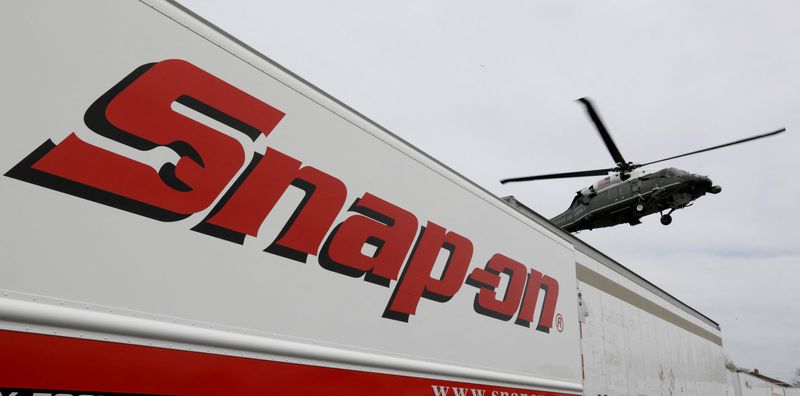By Timothy Aeppel
(Reuters) - Surging inflation and snarled supply lines have hit U.S. manufacturers like Snap-on (NYSE:SNA) Inc over the past year, but so far haven't hurt profits.
The toolmaker, which turned 102 this year, just notched its second-highest quarterly operating profit margin ever, 20.3%, only slightly below the 21% record set a quarter earlier. Sales in the first quarter exceeded pre-pandemic level by 19%.
Chief Executive Nick Pinchuk, speaking to Reuters, said the company has dealt with inflation headwinds by raising prices, curbing discounts, and finding creative ways to cut costs - including, in some cases, redesigning products to get around shortages of key materials or parts.
"The biggest problem these days isn't inflation," he said. It's the continued waves of supply chain disruptions."
Many companies - including other larger U.S. industrial firms - have also seen profits grow amid the chaos, and investors are watching the influx of quarterly earnings reports this week and next to see if that trend continues.
Continuing these gains could get harder. Companies now face the added challenge of rising interest rates as the Federal Reserve tightens monetary policy, along with a war in Ukraine. On Tuesday, General Electric (NYSE:GE) Co said new lockdowns in China and the war in Europe have increased supply chain disruptions and inflation pressures, putting its full-year profit outlook at risk.
Still, S&P 500 companies are estimated to increase earnings by 9% this year, according to Refinitiv IBES.
At Snap-on, Pinchuk said he doesn’t see significant relief on inflation and supply snarls coming any time soon. Both problems, he added, are linked directly to the pandemic - and he expects them to linger so long as waves of illness remain a barrier to normal flows of trade and production.
For now, much of that focus is on the shutdowns in China. Pinchuk said he has a manager who recently had to catch a ride on a vegetable truck to reach the airport in Shanghai, because so many other forms of transportation have been curbed.
"If Shanghai opens soon, people will be able to start to catch up," he said. But now shutdowns are spreading, including recent moves to curb activity in Beijing.
Snap-on has an advantage at a time of shortages, said Pinchuk, because they sell directly to consumers. Snap-on trucks, which carry up to 4,000 different items, visit auto repair shops and other businesses to sell directly to technicians and mechanics. Customers can order thousands more items through this mobile sales fleet.
Having this close link to end buyers allowed Snap-on to move quickly over the past year to curb promotions on items that are hard to produce, while encouraging sales of items that aren’t, said Pinchuk. He refers to this as "invisible pricing."
The company also rushed to redesign products - or manufacturing processes - to get around shortages and other factory floor bottlenecks. Take toolboxes. The company long used stainless steel to build the drawers for these storage units, because they could be molded into shape and offer durability without special coatings other added treatments.

With stainless steel in short supply and extremely pricy, Snap-on began using cold-pressed steel instead for these parts. That meant the added cost and complication of coating and painting the metal to be rust resistant.
"But this is the environment we're in," said Pinchuk. "We're in shortage and costs are going up - and we're going to focus on breaking our processes to deal with it."